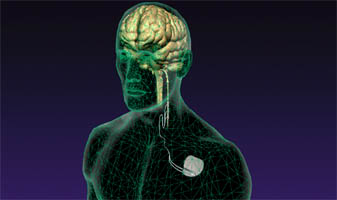Cerbomed GmbH: transcutaneous Vagus Nerve Stimulation for pain relief
Published: August 23, 2012
ERLANGEN, Germany — The medical device company cerbomed GmbH from Erlangen, Germany has received the European clearance (CE mark) for the application of transcutaneous Vagus Nerve Stimulation (t-VNS) in pain relief therapy.
Pain-relieving effect of t-VNS
A randomized study on pain processing was conducted in cooperation with the university of Regensburg in 2011. With t-VNS, there was a significant reduction of perceived mechanical pain in healthy volunteers (Busch et al., Brain Stimulation, in press).
In a second randomized controlled study, pain processing in the right and left hand was examined on 49 healthy volunteers on three different days. The effect of a dextral t-VNS after stimulation of the left ear was also examined for the first time. In both cases, t-VNS reduced pain perception following mechanical stimuli significantly.
“The current results and literature data form the foundation of the clinical study on the effect of t-VNS in chronic migraine treatment. It is conducted by the Headache Center of the Neurological Department at the Großhadern Hospital in Munich”, explains Prof. Dr. Jens Ellrich, Chief Medical Officer of cerbomed GmbH. The randomized controlled study is examining the efficacy of t-VNS on 98 patients suffering from chronic migraine.
From August 27th to 31st, cerbomed will be presenting t-VNS to an expert audience at the 14th World Congress on Pain in Milan, which is organized by the International Association for the Study of Pain.
About t-VNS
Transcutaneous Vagus Nerve Stimulation is addressed to patients suffering from various difficult to treat neurological and psychiatric diseases. The t-VNS therapy uses the fact that a branch of the vagus nerve is located directly under the skin in areas of the outer ear and therefore can be stimulated through the skin (transcutaneously) with electrical impulses.
About cerbomed
Cerbomed is an innovative medical device company located in Erlangen, Germany, that focuses on neuromodulation. The company, founded in 2005, focuses on transcutaneous Vagus Nerve Stimulation (t-VNS), which may offer an attractive therapy option for patients with hard-to-treat neurological and psychiatric illnesses.
Find out more about cerbomed at www.cerbomed.com
http://www.heraldonline.com/2012/08/23/4208412/cerbomed-gmbh-transcutaneous-vagus.html
ERLANGEN, Germany — The medical device company cerbomed GmbH from Erlangen, Germany has received the European clearance (CE mark) for the application of transcutaneous Vagus Nerve Stimulation (t-VNS) in pain relief therapy.
Pain-relieving effect of t-VNS
A randomized study on pain processing was conducted in cooperation with the university of Regensburg in 2011. With t-VNS, there was a significant reduction of perceived mechanical pain in healthy volunteers (Busch et al., Brain Stimulation, in press).
In a second randomized controlled study, pain processing in the right and left hand was examined on 49 healthy volunteers on three different days. The effect of a dextral t-VNS after stimulation of the left ear was also examined for the first time. In both cases, t-VNS reduced pain perception following mechanical stimuli significantly.
“The current results and literature data form the foundation of the clinical study on the effect of t-VNS in chronic migraine treatment. It is conducted by the Headache Center of the Neurological Department at the Großhadern Hospital in Munich”, explains Prof. Dr. Jens Ellrich, Chief Medical Officer of cerbomed GmbH. The randomized controlled study is examining the efficacy of t-VNS on 98 patients suffering from chronic migraine.
From August 27th to 31st, cerbomed will be presenting t-VNS to an expert audience at the 14th World Congress on Pain in Milan, which is organized by the International Association for the Study of Pain.
About t-VNS
Transcutaneous Vagus Nerve Stimulation is addressed to patients suffering from various difficult to treat neurological and psychiatric diseases. The t-VNS therapy uses the fact that a branch of the vagus nerve is located directly under the skin in areas of the outer ear and therefore can be stimulated through the skin (transcutaneously) with electrical impulses.
About cerbomed
Cerbomed is an innovative medical device company located in Erlangen, Germany, that focuses on neuromodulation. The company, founded in 2005, focuses on transcutaneous Vagus Nerve Stimulation (t-VNS), which may offer an attractive therapy option for patients with hard-to-treat neurological and psychiatric illnesses.
Find out more about cerbomed at www.cerbomed.com
http://www.heraldonline.com/2012/08/23/4208412/cerbomed-gmbh-transcutaneous-vagus.html

